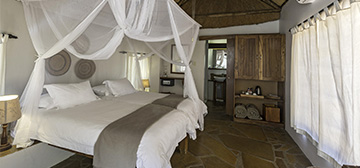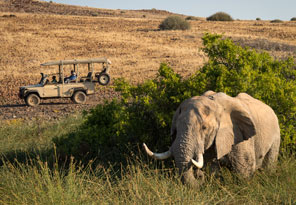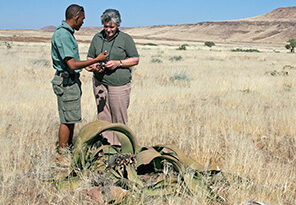
Onguma Camp Kala
- Onguma Game Reserve, NamibiaIn November 2022, Onguma launched Camp Kala, a new ultra-exclusive lodge situated right next to a very busy waterhole in the 34,000 ha Onguma Nature Reserve in Namibia.
Desert Rhino Camp lies amongst rolling, rocky hills of the 450 000-hectare Palmwag Concession. This region is marked for its tranquil, minimalist beauty, surprising wealth of arid-adapted wildlife and the largest free-roaming black rhino population in Africa.
Set in a wide valley, accommodation at Desert Rhino Camp consists of eight raised Meru-style canvas tents with front verandas to take in the sweeping views in front dotted with scattered euphorbia and ancient welwitschia plants, and the dramatic Etendeka Mountains. The comfortable tented dining and lounge area is also elevated with partially open sides offering those panoramic views while a swimming pool provides a refreshing respite during the midday heat. Evening meals are often taken around the fire pit under the starry skies, known for their clarity.
Outings are geared at exploring this vast, miraculous ecosystem with some of the most knowledgeable guides in Namibia – and of course tracking the black rhino.
We typically set out in the morning on game drive vehicles, behind the Save the Rhino trackers, who keep records on where and when previous rhino were seen. This enables them to track the rhino, although due to the vast terrain we sometimes drive long distances to view them. Once we have located an animal, tracking by foot can take place depending on the position or location of the rhino.

Game drives showcase the magnitude of the landscape and offer the best possibilities of seeing desert-adapted wildlife including rhino, elephant, giraffe, antelope, zebra and maybe even the area’s predators.

Learn more about the smaller flora and fauna that live in this incredibly harsh environment. Adaptation to the desert environment is the miracle of all that survives here.

Travel amongst rolling, rocky hills with scattered euphorbia, ancient welwitschia plants, scrubby vegetation and isolated clumps of trees through the 450 000-hectare Palmwag Concession and search out the fascinating desert-adapted wildlife of the region.

Birding enthusiasts are sure to enjoy the diverse avifauna found in the Palmwag Concession. Key species to look out for include Rüppell's korhaan, Benguela long-billed lark and possibly Herero chat with some focused searching. Verreauxs' eagle is often sighted around rocky hillsides.

Aside from the desert-adapted black rhino to be found in the area, Palmwag Concession's freshwater springs also support healthy populations of desert-adapted elephant, Hartmann's mountain zebra, giraffe, gemsbok, springbok, kudu and predators such as lion, cheetah, leopard, and brown and spotted hyaena. Birdlife is prolific and diverse with most of Namibia's endemics present.